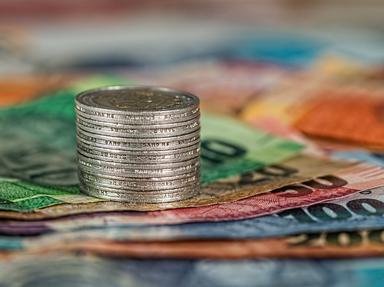Quiz Answer Key and Fun Facts
1. First we will travel to Alexandria, Egypt, where our friends the archaeologists have dug up remnants of a 4000-year-old marketplace. Here we find various sizes and weights of different metals (mainly copper and gold). After decades of detailed research, we find evidence of a culture that used taxes, credit, and bookkeeping, but we can't find any coins. What would be the most appropriate action for our research group to do?
2. After our Egyptian dig, we fly to China in search of Chinese currency. We are lucky enough to find a well-preserved marketplace near Beijing. We find cubes of gold and slabs of bronze. What is the bronze currency commonly called?
3. Our successful dig in China funds our next trip to Lydia within Asia Minor. There we visit a museum that houses one of the oldest known coins to be made. The stater of Lydia, a small oval coin, is on display. As I read the plaques describing the coin I learn that the stater of Lydia is composed of a natural alloy of gold and silver, but my Arabic is a little rusty and I can't make out the name of that alloy. Can you help me?
4. This museum also has an exhibit of the first gold coin ever made. This is the gold stater of...?
5. Next we decide to travel to Rome, and on the way we come across a Roma street merchant selling replicas of a coin called the silver tetradrachm. He claims that this was the first international coin and was also the first coin to have a portrait of a man's face on the front of the coin. The replica lacks luster and I can't tell whom the portrait is of. Who is it?
6. In Rome we come across the remains of a large building with the word "Moneta" etched in its cornerstone. What was this building?
7. While digging through the moneta I come across a coin that has the same symbol of a bundle of rods with an ax that is found on the back of today's Mercury dimes. What is this symbol called?
8. While taking a break from digging, our group encounters a local historian who challenges our wits with the following question: "In which modern country's area were the gold florin and ducat coins first issued?"
9. Our local history buff then poses yet another coinage question: "What coin pictured Napoleon Bonaparte crowned with laurel leaves like a Roman emperor?"
10. After finishing our work in Rome, we take the next plane home. On the flight I glance out the window and to my surprise I spot the image of a dove in the clouds. Still thinking about coins, I say to myself, "The dove is on the ten centesimi coin issued in what country?"
Source: Author
wendypco
This quiz was reviewed by FunTrivia editor
bullymom before going online.
Any errors found in FunTrivia content are routinely corrected through our feedback system.
